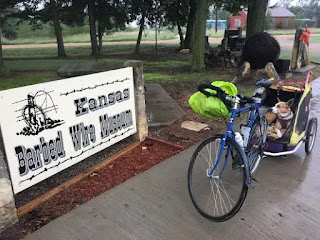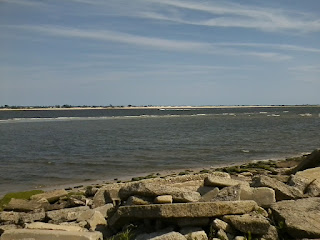Many years ago, I read John Steinbeck's Travels With Charley.
In the book, he and his traveling companion set out on a trek that took them through 40 of the 50 US states. He took this trip, he said, because he felt he'd lost touch with America. If anything, he might have been trying to recapture his youth: He was nearing 60, and his physical and mental health were failing him. I suspect he might've been suffering from "writer's block."
So, he outfitted a three-quarter-ton pickup track as a camper and set out from his Sag Harbor, NY home. And he allegedly recorded--and replicated in the book--a number of conversations with "ordinary" Americans.
Even at such a tender age, I had my suspicions about his account. Some things just didn't seem quite right; later on, when I'd read more of his fiction, I felt as if some of those conversations sounded like the dialogue in his stories. And I had to wonder whether he was alone--save for Charley--and roughing it as much as his book made it seem he was.
Still, I enjoyed it: after all, Steinbeck could tell--or, more precisely, reveal--a story. In fact, Travels With Charley might have been the first book that showed me how the truth of the story is more compelling than the mere chronological or spatial correctness of its facts. Even if he wasn't in Alice, North Dakota at the exact moment he related in the book, what he was learning while traveling the windswept plains is interesting and, at times, compelling.
I'm mentioning Travels With Charley because of the traveling companion in Steinbeck's title: his French poodle. I must say that I like French poodles as much as anyone else, but I'm not sure that it would be the breed I'd choose to accompany me on a trip.
Perhaps I'd choose a hound--at least for a bike trip, as hounds generally like to be outdoors. Now, I'm sure Paul Stankiewicz didn't choose his "Charley"--whose name is Mona--specifically for his trip across the USA. But the pooch--an 8-year-old mixture of English fox hound and Egyptian Pharaoh hound--accompanied him on a drive from their New Hampshire home to California and, more important (for this blog, anyway), on an 8000 kilometer (5000 mile) bike ride back to the Granite State.
They arrived two weeks ago--he, 10 pounds lighter than he started and she having survived being struck by a car. Fortunately, she suffered nothing more than a few scrapes and a stiff neck. Perhaps not surprisingly, she and Stankiewicz developed a bond after spending four months on the road together.
He undertook this journey on a Trek 520 he bought used and "fixed up for touring" with lower gears and new brakes. I'm sure he needed both in towing a trailer that carried Mona, as well as supplies for him and her.
Now that he's home, he's looking for a job. At least, the news reports and blog he kept of his journey can vouch for what he did during that four-month employment gap in his resume.
And, on returning home there have been adjustments. For example, he says that on such a trip, "You kind of lose track of time, like it's a Sunday afternoon." That's a pretty fair description of how it feels in the middle of a multiday (or multiweek) trip. That might be the reason why, he now feels like he's "going so fast" when he's driving his car at 30 or 40 miles per hour.
In the book, he and his traveling companion set out on a trek that took them through 40 of the 50 US states. He took this trip, he said, because he felt he'd lost touch with America. If anything, he might have been trying to recapture his youth: He was nearing 60, and his physical and mental health were failing him. I suspect he might've been suffering from "writer's block."
So, he outfitted a three-quarter-ton pickup track as a camper and set out from his Sag Harbor, NY home. And he allegedly recorded--and replicated in the book--a number of conversations with "ordinary" Americans.
Even at such a tender age, I had my suspicions about his account. Some things just didn't seem quite right; later on, when I'd read more of his fiction, I felt as if some of those conversations sounded like the dialogue in his stories. And I had to wonder whether he was alone--save for Charley--and roughing it as much as his book made it seem he was.
Still, I enjoyed it: after all, Steinbeck could tell--or, more precisely, reveal--a story. In fact, Travels With Charley might have been the first book that showed me how the truth of the story is more compelling than the mere chronological or spatial correctness of its facts. Even if he wasn't in Alice, North Dakota at the exact moment he related in the book, what he was learning while traveling the windswept plains is interesting and, at times, compelling.
I'm mentioning Travels With Charley because of the traveling companion in Steinbeck's title: his French poodle. I must say that I like French poodles as much as anyone else, but I'm not sure that it would be the breed I'd choose to accompany me on a trip.
Perhaps I'd choose a hound--at least for a bike trip, as hounds generally like to be outdoors. Now, I'm sure Paul Stankiewicz didn't choose his "Charley"--whose name is Mona--specifically for his trip across the USA. But the pooch--an 8-year-old mixture of English fox hound and Egyptian Pharaoh hound--accompanied him on a drive from their New Hampshire home to California and, more important (for this blog, anyway), on an 8000 kilometer (5000 mile) bike ride back to the Granite State.
They arrived two weeks ago--he, 10 pounds lighter than he started and she having survived being struck by a car. Fortunately, she suffered nothing more than a few scrapes and a stiff neck. Perhaps not surprisingly, she and Stankiewicz developed a bond after spending four months on the road together.
He undertook this journey on a Trek 520 he bought used and "fixed up for touring" with lower gears and new brakes. I'm sure he needed both in towing a trailer that carried Mona, as well as supplies for him and her.
 |
| Mona, recovering from her injuries |
Now that he's home, he's looking for a job. At least, the news reports and blog he kept of his journey can vouch for what he did during that four-month employment gap in his resume.
And, on returning home there have been adjustments. For example, he says that on such a trip, "You kind of lose track of time, like it's a Sunday afternoon." That's a pretty fair description of how it feels in the middle of a multiday (or multiweek) trip. That might be the reason why, he now feels like he's "going so fast" when he's driving his car at 30 or 40 miles per hour.
































